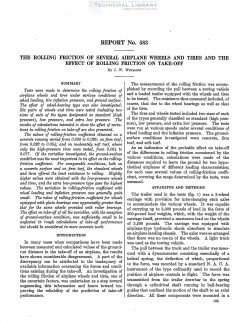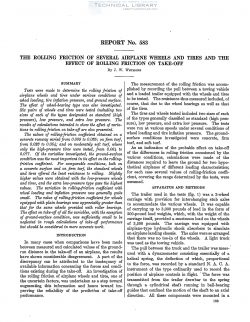naca-report-583

- Version
- 246 Downloads
- 731.39 KB File Size
- 1 File Count
- August 30, 2016 Create Date
- August 30, 2016 Last Updated
National Advisory Committee for Aeronautics, Report - The Rolling Friction of Several Airplane Wheels and Tires and the Effect of Rolling Friction on Takeoff

Tests were made to determine the rolling friction of
airplane wheels and tires under various conditions of
wheel loading, tire inflation pressure, and ground surface.
The efiect of wheel-bearing type was also investigated.
Sis: pairs of wheels and tires were tested including two
sizes of each of the types designated as standard (high
pressure), low pressure, and extra low pressure. The
results of calculations intended to show the efiect of variar
tions in rolling friction on take-of are also presented.
The values of rolling-friction coefiicient obtained on a
concrete runway varied from 0.009 to 0.035; on firm turf,
from 0.023 to 0.054; and on moderately soft turf, where
only the highppressure tires were tested, from 0.064 to
0.077. 0f the variables investigated, the ground-sun‘ace
condition was the most important in its efl'ect on the rolling-
friction coeficient. For comparable conditions, both on
a concrete surface and on firm turf, the standard wheels
and tires oflered the least resistance to rolling. Slightly
higher values were obtained with the low-pressure wheels
and tires, and the eaztra low-pressure type gave the highest
values. The variation in rolling-friction coeflicient with
wheel loading and inflation pressure was generally quite
small. The value of rolling-fiiction coefiicient for wheels
equipped with plain bearings was appreciably greater than
that for the same wheels provided with roller bearings.
The West on take-of of all the variables, with the exception
of ground-surface condition, was suficiently small to be
neglected in rough calculations of take-of performance
but should be considered in more accurate work.
In many cases when comparisons have been made
between measured and calculated values of the ground—
run distance in the take-off of an airplane, the results
have shown considerable disagreement. A part of the
discrepancy can be attributed to the inadequacy of
available information concerning the forces and condi-
tions existing during the take-off. An investigation of
the rolling friction of airplane wheels and tires, one of
the uncertain factors, was undertaken as a step toward
augmenting this information and hence toward im-
proving the reliability of the prediction of take-off
performance.
| File | Action |
|---|---|
| naca-report-583 The Rolling Friction of Several Airplane Wheels and Tires and the Effect of Rolling Friction on Takeoff.pdf | Download |

Comment On This Post